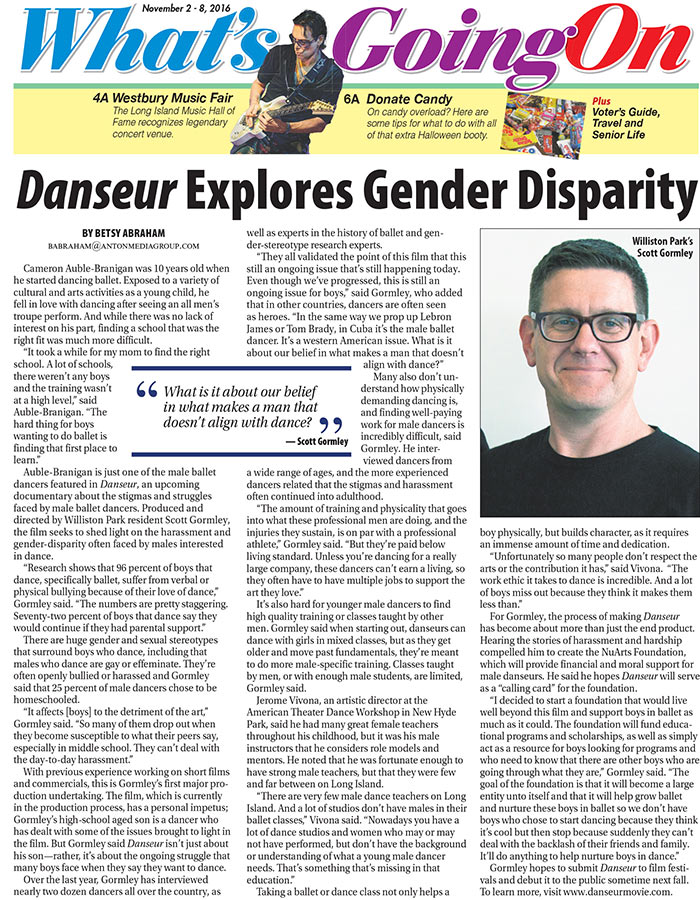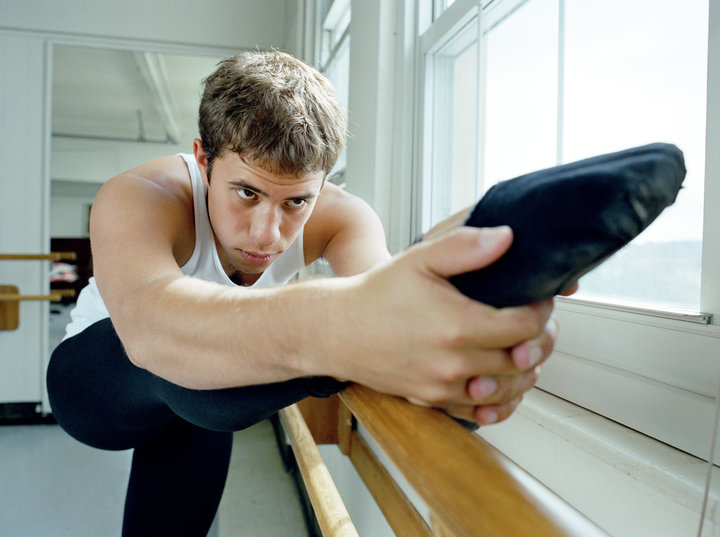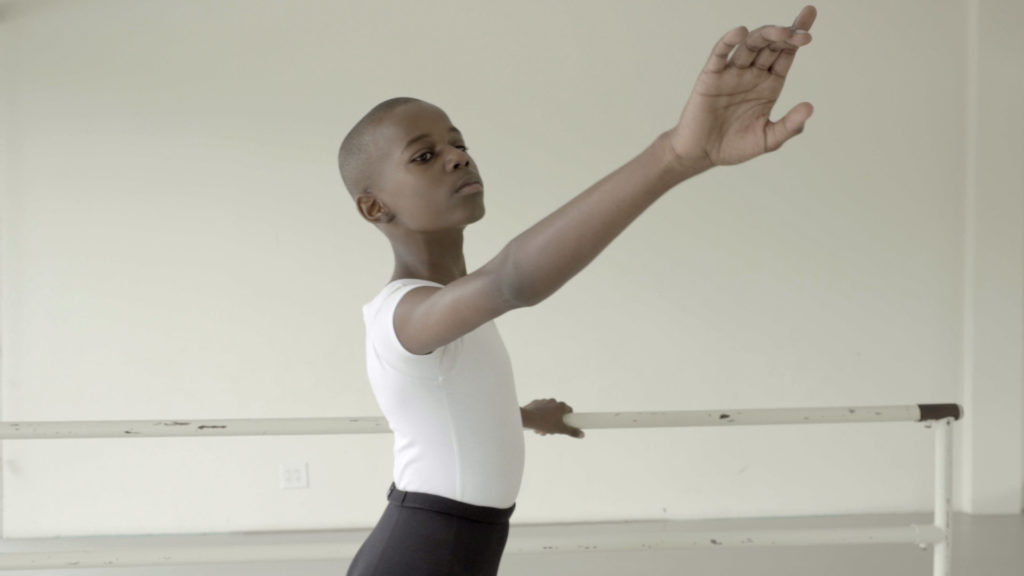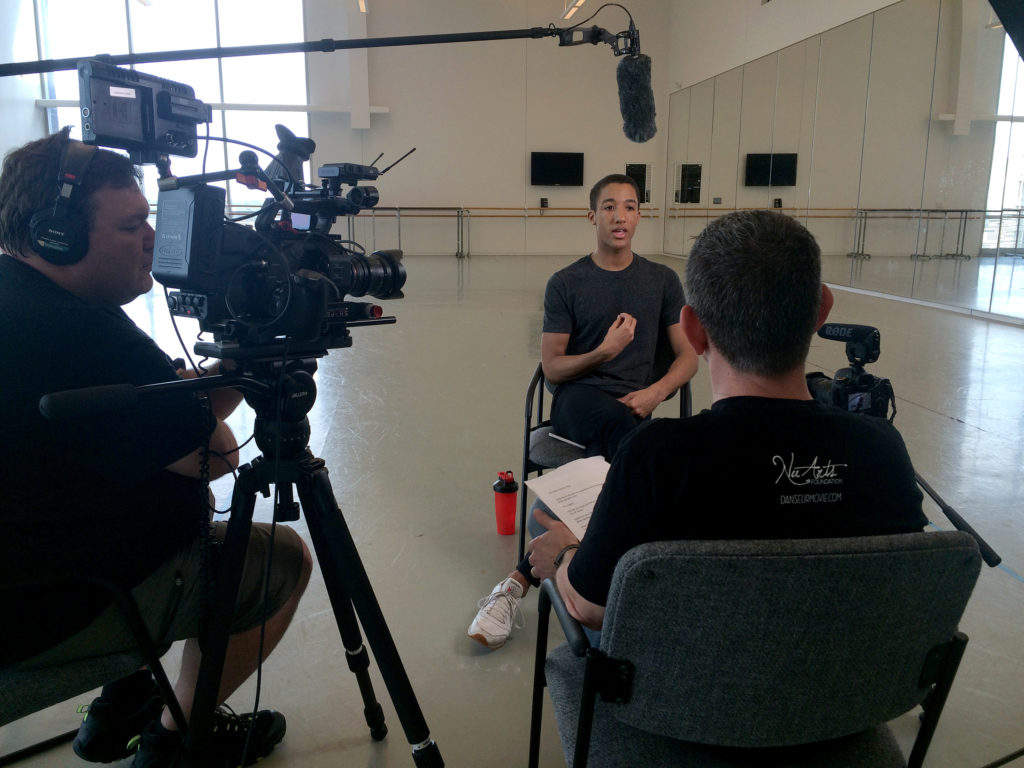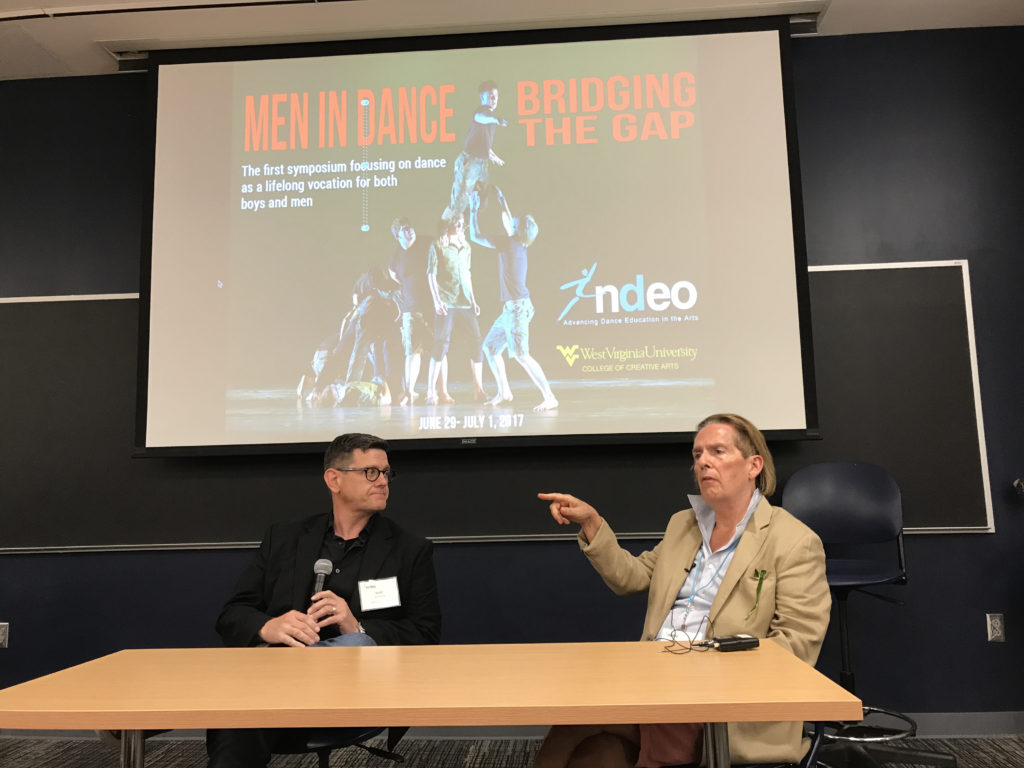IN THE NEWS
Pittsburgh Post-Gazette
A Point Park student inspires new film about male bullying in ballet
Huffington Post
The Greatest Obstacle For Boys Who Do Ballet Is Often Their Own Fathers
Houston Chronical
‘Danseur’ examines stereotypes of male ballet dancers
sdpnoticias.com
Los Niños Que Hacen Ballet
meaww.com
“I just wanted the bullying to stop”: ‘Danseur’ shows how male dancers combat stereotypes and homophobia in the ballet industry
The Advocate
All Male Ballet Dancers Are Gay, Right?
CW39 Houston
Tights & Taunting! ‘Danseur’ documentary unveils brutal bullying of boy dancers
dancelife.com.au
DANSEUR Examines Bullying of Ballet Boys
NBC Nightly News
New documentary highlights difficulties faced by male dancers
POINTE Magazine
Upcoming “Danseur” Documentary Confronts the Social Stigma of Being a Boy in Ballet
CONTACT Geena Russo
MEDIA INQUIRES
Tights & Taunting! ‘Danseur’ documentary unveils brutal bullying of boy dancers
POSTED 9:52 AM, JUNE 27, 2018, BY MAGGIE FLECKNOE, UPDATED AT 10:46AM, JUNE 27, 2018
HOUSTON — Tights and taunting! Being a boy in the ballet is not easy. Danseur, a new documentary, unveils the brutal bullying of boy dancers.
Making his documentary debut, Producer and Director Scott Gormley knows this all to well. Gormley decided to explore this after his young son was bullied while pursuing his dream of becoming a ballet dancer.
Gormley sat down with morning dose.’s Maggie Flecknoe to talk more about this passion project and what he hopes Danseur will do for the ballet community.
They continued their discussion on Facebook Live. Watch below:
Tights & taunting! 'Danseur' documentary unveils brutal bullying of boy dancers
Tights, Tutus & taunting! New documentary Danseur follows journey of boys braving bullies while pursuing their ballet dreams. Director Scott Gormley of joins Maggie in the Mornings to discuss the documentary & his personal connection.Click here for interview –> https://bit.ly/2yK7dPy
Posted by CW39 on Wednesday, June 27, 2018
‘Danseur’ examines stereotypes of male ballet dancers
June 22, 2018 Updated: June 22, 2018 2:23pm
Sexism is built into the fabric of classical ballet, an art form that has always idolized women in toe shoes and tutus while relegating men to the role of partners, at least until the rare superstar emerges.
Way back in the 20th century, Mikhail Baryshnikov and Rudolf Nureyev were icons. The 21st century hasn’t yet discovered a male ballet star of their magnitude.
Even worse, young men who pursue careers as danseurs, or male ballet dancers, are highly likely to be stigmatized and bullied at school — and home — outcasts in a society that only sees ballet as feminine. Never mind that dancers train as hard as the most extreme athletes.
“Danseur,” a new documentary that explores issues facing young men in the ballet world, screens Tuesday evening at Houston Ballet’s Center for Dance. Producer and director Scott Gormley and Houston Ballet soloist Harper Watters, who appears in the film, will give a talk afterward.
“I’ve been told I’m a terrible representative for ballet,” said Watters, who is openly gay. “But I have thick skin. I only use that as a motivation.”
Watters said the stereotype associated with male dancers also affects colleagues who are not gay. But by putting himself out there, he has opened himself up to even more intense derision, bullying and threats.
Gormley, a former advertising industry creative director, initially undertook “Danseur” as a “pure passion project” because he is the father of a young male ballet dancer whose social life changed dramatically in the seventh grade, when buddies he’d had since childhood quit coming to hang out on weekends.
Gormley soon found other parents who saw their boys’ problems, and he felt he had a bigger story to tell after he and screenwriter Russ Mahler interviewed a number of young dancers who told graphic stories of abuse and harassment. “We knew if there were a couple of boys, there were dozens,” he said.
Actually, there are thousands. Doug Risner, a leading dance researcher and a professor at Wayne State University in Detroit, found that 96 percent of men who have studied dance have been targets of teasing, name-calling and other verbal abuse; 70 percent have reported verbal and/or physical harassment; 34 percent have experienced verbal threats or threatening behavior; and 16 percent have reported physical harm or injury.
The bullying and threats come not just from people at school, including coaches, but from parents, siblings and other relatives who may be the least supportive of all.
For some boys, those hurdles are far harder to overcome than the physical demands and years of training it takes to achieve balletic virtuosity and strength. They also outweigh the low salary factor, since male dancers in the U.S., on average, earn $36,000 a year, according to the organization Data USA. (Although they do out-earn women, whose salaries average $29,200.)
Gormley said his son’s issues were not as dramatic as the stories of other boys, and once he entered a performing arts high school, he was encouraged and in his element.
Watters, too, has supportive parents, although as academics — both college English professors — they had to be convinced that quitting a conventional high school to pursue dance was a good idea. Watters is adopted and an only child.
As an African-American, he felt his skin color was his biggest deterrent; that his only option for a career in dance would be with Alvin Ailey American Dance Theater. “That’s where I saw people like me,” he said. “Not that they aren’t great. They are one of my biggest inspirations.”
Watters left home at 14 to attend Walnut Hill School for the Performing Arts in Massachusetts. From there, his friend Joseph Walsh (now a San Francisco Ballet principal) pointed him to Houston, a company widely recognized for its strong men’s coaching program and its history of diversity. It was the home of one of the country’s most high-profile African-American stars, Lauren Anderson; a place that also helped the dark-skinned Cuban Carlos Acosta launch his career.
Gormley, the “Danseur” director, discovered him through social media channels. The crew filmed at Houston Ballet’s studios in 2016, also including Derek Dunn, who now dances with Boston Ballet.
In tandem with the film, Gormley created the NuArts Foundation, a nonprofit devoted to helping young men who want to dance. “I knew the issue was bigger than the movie,” he said. “These boys are going to need help for a long time.”
He hopes to build educational programs and work with middle schools; and NuArts recently sponsored two boys who studied for a few weeks in Australia. His son Jack, now 19, attends Point Park University in Pittsburg and is at the Pittsburgh Ballet Theatre’s school this summer. He does not appear in the film.
“At the end of the day, I didn’t want it to be about him,” Gormley said. “I wanted it to be an issue film.”
Watters, for one, is grateful. “I fight the stereotype because I fit it. That’s something ‘Danseur’ tackles well,” he said. “It’s a really important film.”
All Male Ballet Dancers Are Gay, Right?
ORIGINALLY POSTED ON THE ADVOCATE.COM
Boys who do ballet are gay. That’s the stereotype that filmmaker Scott Gormley goes toe-to-toe with in his new documentary, Danseur.
The film follows several male dancers, some gay, some straight, and sensitively unfolds their relationships with that stereotype and others.

Gormley also confronts the extreme level of bullying that they face. He shares why it was important for him to deal with this issue:
“I’ve spent the last two years creating a documentary about the struggles that young men face when they choose to dance ballet ― when they choose to thumb their nose at what boys “should do.” While directing and producing Danseur, I’ve seen over and over again the clear-cut lines we draw as a society around what boys “should” and “shouldn’t” do. I’ve interviewed more than two dozen dancers, and their stories are heartbreakingly similar. Verbal abuse. Physical abuse. Assault. Researcher Doug Risner of Wayne State University found that nearly 96 percent of all boys who dance have faced verbal and/or physical assaults from their peers, ultimately driving many young danseurs from the studio.
True happiness, we’re so often told, comes from doing what you love. That’s the advice we get from buttons, T-shirts, memes and the self-help industry. But in my son’s case, that advice should come with a big disclaimer: Doing what you love may cause you to be a social outcast, called a ‘faggot,’ physically assaulted by your peers, or generally ostracized by family and friends.
The boys who choose ballet really know what they love and want to do for the rest of their lives, and they have to fight to get it. It is inspiring to witness. We should all be so lucky.”
There will be a free screening in Houston Tuesday in partnership with Houston Ballet. Find out more about Danseur here.
NUARTS PRODUCTIONS ANNOUNCES INTERNATIONAL SCREENINGS FOR DANSEUR DOCUMENTARY
Documentary about Boys Braving Bullies in Pursuit of their Ballet Dreams will Screen in Sydney, Mexico, and New Zealand this year
NEW YORK — NuArts Productions presents DANSEUR, sharing the struggles of young men in pursuit of their ballet dreams, with international screenings in Mexico, at Monterrey International Ballet Gala & Workshop on August 30, 2018; Sydney, Australia in partnership with Royal Academy of Dance Australia and Project B on September 28, 2018 and Wellington, New Zealand on October 3, 2018.
Making his documentary debut, Producer and Director Scott Gormley explores the difficult subjects of bullying and homophobia while illustrating the vitality of ballet, through performance, creation, preservation and education. The film features stories from James Whiteside (American Ballet Theatre), John Lam (Boston Ballet), Harper Watters (The Houston Ballet), Derek Dunn (Boston Ballet), among others.
“I’ve seen over and over again the clear-cut lines we draw as a society around what boys “should” and “shouldn’t” do. I’ve interviewed more than two dozen dancers, and their stories are heartbreakingly similar. Verbal abuse. Physical abuse.” Said Producer and Director Scott Gormley. “In many cases, it’s their own fathers who aren’t in support of their dreams. In this film I wanted to show that ballet is beautiful – across all genders.”
The Australian Premiere is in partnership with the Royal Academy of Dance’s (RAD) Project B – their global initiative to encourage and support more males to learn and teach dance. Accompanying the screening, RAD will host ‘In Conversation With’ Director Scott Gormley, RAD Male Dance Ambassador Matthew Lawrence and Ballet Brothers’ founder Jake Burden. Full schedule of dates, locations and further information can be found below and at danseurmovie.com.
Monterrey International Ballet Gala & Workshop, Monterrey, Mexico
Thursday, August 30, 2018 at 8:00 pm
Invitation only
The screening will held at “Sala Chopin” of the “Escuela Superior de Música y Danza de Monterrey”
In Partnership with Royal Academy of Dance Australia and Project B, Sydney, Australia
Saturday, September 29, 2018 at 5:30 pm
Dendy Opera Quays
Tickets: $25 sold here
For more information, visit RAD events
New Zealand School of Dance, Wellington, New Zealand
Wednesday, October 3, 2018 at 6:30 pm
Embassy Theatre
The screening will be followed by a Q&A from 7:45 – 8:15 pm
###
ABOUT NuArts Productions
Founded by like-minded filmmakers, NuArts Productions LLC is an independent, New York based production company committed to the art of creative storytelling, no matter the media. With the belief that a great story or message is essential to great creative, we combine stunning visuals with universal human experiences to immerse the audience.
ABOUT Producer and Director Scott Gormley
Scott Gormley is a former creative director turned independent film producer. Gormley started NuArts Production, LLC in 2015 concentrating on documentaries so he can help others tell their stories through film. He served on the Board of Directors for Eglevsky Ballet, overseeing the preservation of its 50+ year history.
The Greatest Obstacle For Boys Who Do Ballet Is Often Their Own Fathers
FROM HUFFINGTON POST By Scott Gormley
My son Jack has always loved to dance. When he was 8 years old, he would entertain the family by making up his own dance routines to popular music. So when he asked, at age 11, if he could take formal dance classes, it seemed like a natural extension. Like many other boys, his first experience in the dance world was a hip hop class. But he never really loved it and I could tell that he was becoming bored with dance, so I suggested that he take a ballet class.
Initially Jack was resistant, but he gave it a shot anyway. That was 8 years ago, and he hasn’t stopped dancing ballet since.
In the ballet world, Jack is in the minority: of the 3.5 million children studying dance in the United States today, only 10% are male. Jack was the only boy in his ballet class for the first four years of his training, until he moved to a school that has classes specifically for boys.
Most boys who dance ballet face tremendous resistance — from their families, from friends and from society at large. I’m proud to be in a minority, too: according to Doug Risner, a Professor of Dance at Wayne State University, only 32% of male dancers say their fathers support them dancing. Risner’s research shows that mothers play a critical role in their son’s initial exposure to dance and then in supporting his dance training. But most boys who dance do so without the support of their fathers.
I’ve spent the last two years creating a documentary about the struggles that young men face when they choose to dance ballet — when they choose to thumb their nose at what boys “should do.” While directing and producing Danseur, I’ve seen over and over again the clear cut lines we draw as a society around what boys “should” and “shouldn’t” do. I’ve interviewed more than two dozen dancers, and their stories are heartbreakingly similar. Verbal abuse. Physical abuse. Assault. Risner found that nearly 96% of all boys who dance have face verbal and/or physical assaults from their peers because they choose to dance.
What I found the most upsetting were the attacks that came directly from family members: Fathers, stepfathers, uncles, brothers, many of whom feared that ballet would “turn” boys gay. One dancer I interviewed no longer has contact with his birth father, who was so against his son dancing that that the relationship fell apart.
Americans are taught to praise the athlete practically from birth. We surround young men with images of football and baseball stars, we dress them in miniature jerseys and swaddle them in team blankets. That is our culture — that is our normal. Ballet dancers are artists whose training schedules rival those of elite athletes. A dancer who starts taking ballet class at the age of 8 or 9 will clock nearly 10,000 hours of training and rehearsal by his 18th birthday. Boys and men who dance full-time will log even more hours in the gym at physical therapy, keeping their bodies as strong and fit as those of professional athletes.
That is just the beginning of what so many young dancers sacrifice for their art. Most young dancers are forced into homeschooling, some because of the intense hours they spend in the dance studio each day and some because of the bullying they experience at their traditional school and other. Because for boys, ballet is not normal: the stereotypical dancer is a girl, or an effeminate gay man. And while many believe that as a society, we are making strides to be more understanding and inclusive of those who defy gender norms, the reality for young dancers suggests we aren’t striding fast enough.
This problem goes beyond ballet: we encourage perceived strength over all kinds of artistry and often force boys to play organized sports while diminishing the role of the arts in schools. As a society, we are failing not just ballet danseurs, but boys who want to be violinists or actors or sculptors.
Many of the boys and men I interviewed accepted the bullying and abuse, giving those who torment them the benefit of the doubt. They chalked it up to ignorance or to cultural background. Some almost blamed themselves for the bullying they endured. Peter Weil, who dances with Pennsylvania Ballet, told me, “It’s not normal to be a boy and dance ballet, with all the women and the tights.” Perhaps it was just easier for them to accept the social standard and agree that it’s just not normal for boys to dance ballet.
In order for any of the boys I interviewed to be successful in their pursuit of ballet, they needed a very strong sense of self. It was their defense mechanism: they, unlike the vast majority of boys, simply did not care if they did not fit in. They were going to be who they were, no matter what their peers — or their parents — thought of them.
True happiness, we’re so often told, comes from doing what you love. That’s the advice we get from buttons, T-shirts, memes and the self-help industry. But in my son’s case, that advice should come with a big disclaimer: doing what you love may cause you to be a social outcast, called a “faggot,” physically assaulted by your peers or generally ostracized by family and friends.
The boys who choose ballet really know what they love and want to do for the rest of their lives, and they have to fight to get it. It is inspiring to witness. We should all be so lucky.
Upcoming “Danseur” Documentary Confronts the Social Stigma of Being a Boy in Ballet
FROM POINTE MAGAZINE By Amy Brandt
 “I never wanted to stop dancing, I just wanted the bullying to stop,” says American Ballet Theatre corps member Patrick Frenette in the trailer for Danseur, a new feature-length documentary about the social stigmatization young men face in ballet. His words shed light not only on the prevalence of harassment boys endure from peers outside the studio, but also their passion and determination to keep dancing in spite of it. The film, produced by NuArts Foundation, features interviews with ballet students, teachers and directors, as well as professional dancers like James Whiteside, John Lam, Derek Dunn and Harper Watters. And while screening dates are yet to be determined, Danseur has already generated a lot of social media buzz.
“I never wanted to stop dancing, I just wanted the bullying to stop,” says American Ballet Theatre corps member Patrick Frenette in the trailer for Danseur, a new feature-length documentary about the social stigmatization young men face in ballet. His words shed light not only on the prevalence of harassment boys endure from peers outside the studio, but also their passion and determination to keep dancing in spite of it. The film, produced by NuArts Foundation, features interviews with ballet students, teachers and directors, as well as professional dancers like James Whiteside, John Lam, Derek Dunn and Harper Watters. And while screening dates are yet to be determined, Danseur has already generated a lot of social media buzz.
The documentary is the brainchild of director Scott Gormley. “I have a son who is a dancer, so I watched what he went through,” he told Pointe last week. “I thought, is this typical?” After doing some research and talking to other parents and dancers, he realized that cruel and relentless teasing, along with social isolation and disapproval from peers and adults, was all too common. “It just felt like a message that had to be broadcast. My goal with the film is to educate people about the subject and hopefully start some conversations about what young men face when they choose to dance.”
Gormley spread the word that he was working on the documentary and, after interviewing several young men, developed a teaser. “Once it was on YouTube and people started sharing it, I got more emails and more phone calls,” he says. He eventually reached out to high-profile dancers like Whiteside, who were eager to participate. Gormley noticed common themes from all of them. “No matter who it was, they said they felt like they were an outcast from the general population,” he says, adding that most bullying took place during middle school. “I’d hear that they were embarrassed, that they wouldn’t share with other kids that they were dancing, that they’d disappear after school and make excuses for not participating in sports.” Some were physically assaulted, while others lacked parental support, especially from their fathers.
Coverage of the Men’s Dance Symposium
Focus Turns To Male Dancers At National Dance Education Organization Symposium
By Ryan P. Casey
The sprawling hills and lush greenery of Morgantown, West Virginia, served as the backdrop for “Men in Dance: Bridging the Gap,” the first symposium sponsored by the National Dance Education Organization (NDEO) to focus on male participation in dance.
Approximately 60 dance educators and aficionados converged at West Virginia University June 29 to July 1 to discuss practical remedies to the dearth of male dancers in schools, studios, and companies. The goal was to devise and share methods to recruit and retain male dancers; discussion topics included what kinds of teaching practices appeal to male dancers, what kinds of classes and programs prove successful with that population, and what kinds of support systems can be implemented for them at any age.
Symposium participants came from across the U.S. as well as from the U.K.; some had elementary, secondary, and higher education experience; some directed or worked for private studios or arts organizations. Even a male dancer’s parent and a researcher from the Harkness Center for Dance Injuries at New York University attended.
According to conference co-founder Barry Blumenfeld, a New York City-based teacher and choreographer, the event took shape over the past five years.
“It started because I wanted to hang out more with some of the guys who are part of NDEO, since there are so few of them,” he says. In 2011, he formed a Special Interest Group, an NDEO online forum that allows members to share issues and propose solutions around a particular topic. More than 550 members have since joined this group, called Men in Dance, to discuss the unique challenges facing males in dance.
DANSEUR featured in Huffington Post
Tights, Tutus and ‘Relentless’ Teasing: Inside Ballet’s Bullying Epidemic
“If this were not the arts, it would be considered a child health crisis.”
DANSEUR Opens NDEO’s Men in Dance Symposium
 We were so honored to open the the first NDEO Men in Dance Symposium at the University of West Virginia on June 29, 2017. The conference was filled with educators, dancers and arts administrators – all of whom came together to help address the issues that face the male dancer. The three day conference was filled with sessions and discussions about issues ranging from gender norms to harassment and bullying. Alongside award-winning dance researcher Doug Risner, we presented a early rough cut of the film to an eager and appreciative crowd. The conference was a wonderful opportunity for us to fine tune the points that really resonate with both professional dancers and educators alike.
We were so honored to open the the first NDEO Men in Dance Symposium at the University of West Virginia on June 29, 2017. The conference was filled with educators, dancers and arts administrators – all of whom came together to help address the issues that face the male dancer. The three day conference was filled with sessions and discussions about issues ranging from gender norms to harassment and bullying. Alongside award-winning dance researcher Doug Risner, we presented a early rough cut of the film to an eager and appreciative crowd. The conference was a wonderful opportunity for us to fine tune the points that really resonate with both professional dancers and educators alike.
We greatly appreciate and thank the NDEO for offering us this opportunity and we hope DANSEUR inspired everyone to work together to end bullying and harassment of men because they love to dance.

DANSEUR Keynote Address at Men in Dance Symposium
Men in Dance: Bridging the Gap – Symposium
Thursday, June 29 – Saturday, July 1, 2017
West Virginia University, College of Creative Arts
The producer/director of DANSEUR in conjunction with Doug Risner, Author of Stigma and Perseverance in the Lives of Boys Who Dance have been invited to host the keynote address at the Men in Dance Symposium. The conference addresses the significant lack of male dancers in the field, how and why it is such a challenge. From early childhood dance and movement classes through secondary education and beyond, the dance world is faced with the question of how to attract more boys and men to the field. This problem is not limited to one genre of dance, age group, or country; the dilemma is global. This symposium seeks pragmatic solutions to address the dearth of male dancers in our studios, schools, and companies as students, professionals, and educators.



